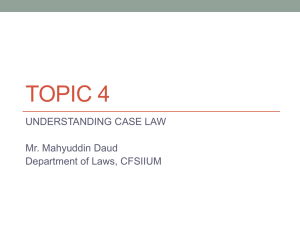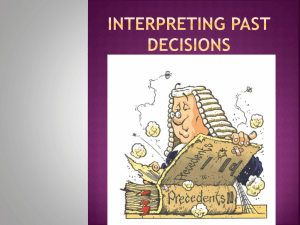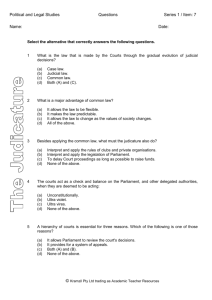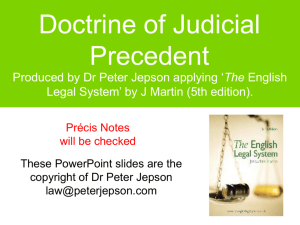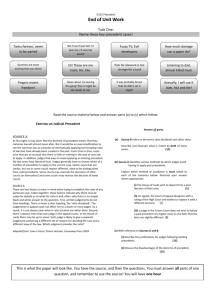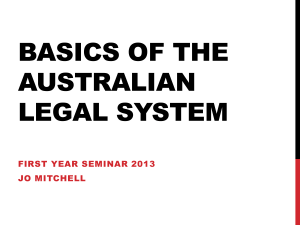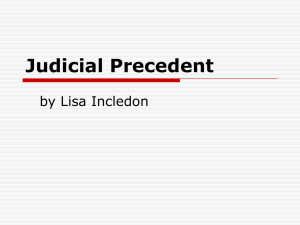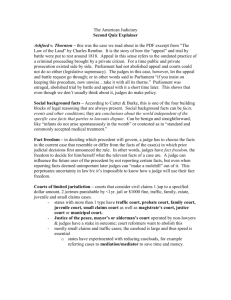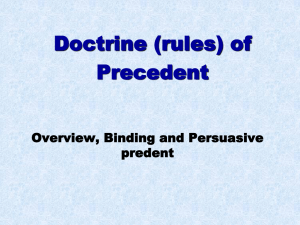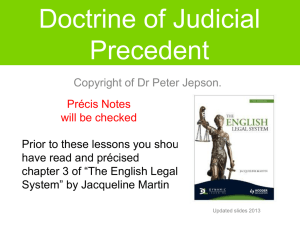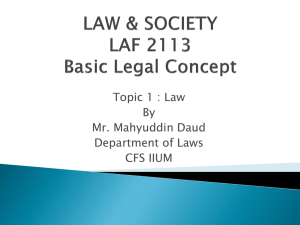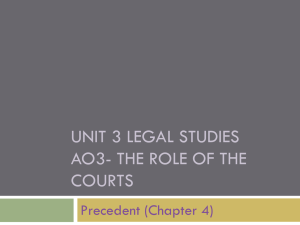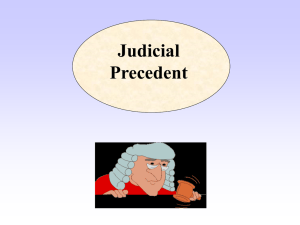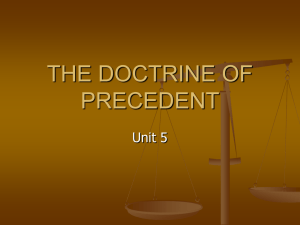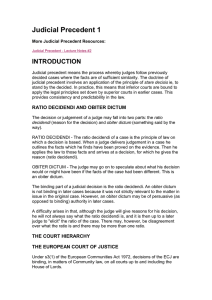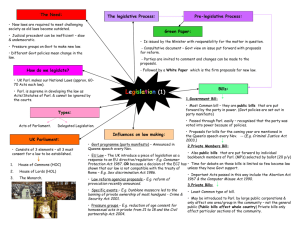LAWS101 @ Carrington Tutorial 8 Case Analysis
advertisement
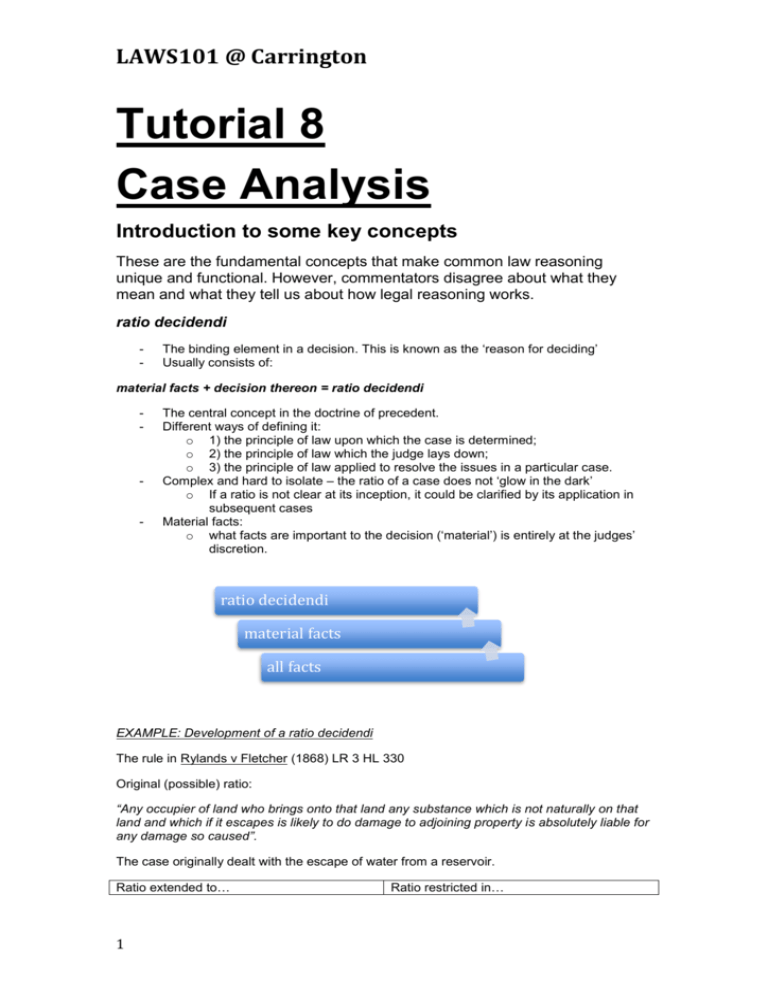
LAWS101 @ Carrington Tutorial 8 Case Analysis Introduction to some key concepts These are the fundamental concepts that make common law reasoning unique and functional. However, commentators disagree about what they mean and what they tell us about how legal reasoning works. ratio decidendi - The binding element in a decision. This is known as the ‘reason for deciding’ Usually consists of: material facts + decision thereon = ratio decidendi - - - The central concept in the doctrine of precedent. Different ways of defining it: o 1) the principle of law upon which the case is determined; o 2) the principle of law which the judge lays down; o 3) the principle of law applied to resolve the issues in a particular case. Complex and hard to isolate – the ratio of a case does not ‘glow in the dark’ o If a ratio is not clear at its inception, it could be clarified by its application in subsequent cases Material facts: o what facts are important to the decision (‘material’) is entirely at the judges’ discretion. ratio decidendi material facts all facts EXAMPLE: Development of a ratio decidendi The rule in Rylands v Fletcher (1868) LR 3 HL 330 Original (possible) ratio: “Any occupier of land who brings onto that land any substance which is not naturally on that land and which if it escapes is likely to do damage to adjoining property is absolutely liable for any damage so caused”. The case originally dealt with the escape of water from a reservoir. Ratio extended to… 1 Ratio restricted in… LAWS101 @ Carrington - fire electricity gas gypsies - unruly tenants school children dangerous goods To think about: - Is it ever possible to isolate a single ratio from a decision? What is the correct level of abstraction to analyse the facts of a decision to decide upon its ratio? obiter dictum - Comments or statements which are not part of the ratio are referred to as dicta or obiter dicta. dicta = comment by the judge which is pertinent to the issue of the case, but is not part of the ratio obiter dicta = casual comment of the judge which is unrelated to the issue of the case. dicta remain persuasive, while obiter dicta are not. precedent - Allows development of the Common Law by recognising decisions against our hierarchy of courts. The ‘doctrine of precedent’ is itself a judge-made common law concept. No statute dictate that previous cases on similar facts must be followed. Based around the concept that ‘like cases should be decided alike’. This is rationalised in a number of ways: o It is an innate characteristic of the human psyche that like cases ought to be determined in a like manner. o Making similar decisions on similar facts provides legal certainty and predictability from case to case, so that people may know what the likely outcome of the next case will be. This is how lawyers are able to advise clients. o Following previous decisions enables a body of legal rules to be build up (the common law) reasoning by analogy - To decide which cases are ‘alike’, judges reason by analogy: find a relationship between the case being decided, and previous decisions. This involves 3 steps: 1) similarities are seen between the two cases; 2) the rule of law from the first case (ratio decedendi) is announced; 3) that rule of law is then applied (or not applied) to the facts of the later case. Perhaps the most famous example of this is the reasoning of Lord Atkin in Donoghue v Stevenson [1932] AC 562. - 2 Binding precedents o The highest decision of courts within the NZ hierarchy is binding on cases which have materially similar facts. o NB: A binding precedent can be overruled by either: A higher court (e.g the Supreme Court overruling the Court of Appeal) The legislature (by enacting a statute/Act of Parl) LAWS101 @ Carrington - Persuasive precedents o Decisions of lower courts of by the highest courts of foreign jurisdictions (especially the High Court of Australia, Supreme Court of Canada and the House of Lords in the UK) are said to be ‘persuasive’ but are not binding in our hierarchy of Courts. To think about: - - To what extent can legal reasoning be a ‘formal’ or scientific process? o Given that finding an analogy between past and present cases is a highly subjective exercise? To what extent do judges take into account non-legal matters in their decisions? o Does a judge’s background and viewpoints affect how he or she makes decisions? Should they? Can judges ever be neutral? stare decisis - Courts are bound by decisions of higher courts in the same jurisdiction which are ‘on all fours’ with the case presently being decided. Courts have discretion as to which precedent cases are followed. The concept of distinguishing allows this: distinguishing - When a Court refuses to follow an earlier decision upon the ground that the facts of the present case differ from those of the earlier decision. Means that Courts are not bound by previous decisions, allows departure at the discretion of the judge. EXAMPLE: Attempt by counsel in Grant v Australian Knitting Mills [1936] AC 85 to distinguish the facts of Donoghue v Stevenson [1932] AC 562 on the basis that there was a possibility of intermediate examination. To think about… - Given that distinguishing a case relies entirely on the judges’ own subjective reading of the facts in the case before him or her, can we predict with certainty what the law will be when another judges is presented with the same question? overruling - 3 A superior Court can overrule the decision of a lower court, expressly or impliedly. This means the ratio decedendi of the previous case is ‘no longer good law’.
